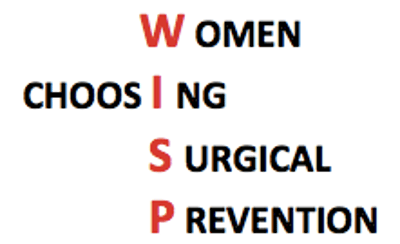The Women Choosing Surgical Prevention (WISP) Trial

Update: As of 10/26/2020 the WISP study has closed for enrollment.
About the Study
The goal of the WISP Study is to compare whether removal of only, delaying removal of the ovaries can safely improve sexual functioning and menopausal symptoms compared to standard risk-reducing removal of the ovaries and (also known as risk-reducing salpingo-oophorectomy or ).
This Study is Open To:
Update: As of 10/26/2020 the WISP study has closed for enrollment.
This Study is NOT Open To:
Update: As of 10/26/2020 the WISP study has closed for enrollment.
What the Study Involves
This is a study. Women who participate in this study will be able to choose which type of ovarian procedure they wish to undergo:
- removal () followed later by a second surgery to remove their ovaries later.
- Removal of the ovaries and tubes immediately. This is the current standard-of-care recommendation for women at high risk for ovarian cancer.
Background
Removal of the ovaries and (also known as Risk-Reducing Salpingo-Oophorectomy or ) is the recommended way for high-risk patients with certain types of genetic mutations to lower their risk for ovarian cancer. With the and ovaries are removed at the same time and women who have not yet reached menopause may experience symptoms and long-term side effects of early-onset menopause. New research suggests that many ovarian cancers may actually begin in the leading patients and researchers to wonder if they could keep the ovaries until closer to natural menopause and still lower their risk by removing the (with or without one ovary) only, followed by ovarian removal several years later.
Study Goal
The goal of this clinical research study is to compare the changes in female sexual function between patients having interval with delayed (ISDO) with those having risk-reducing salpingo-oophorectomy () in women who carry genetic mutations. Researchers also want to learn how these surgeries affect your quality of life.
ISDO is surgery to remove the first, then the ovaries are removed during a second, later surgery. Most women with genetic mutations will be encouraged to remove the ovaries around the ages of 40 to 50. The decision in timing to remove your ovaries will be made with your doctor.
Study Lead Investigator
Principal Investigator: Karen H. Lu, MD M.D. Anderson Cancer Center